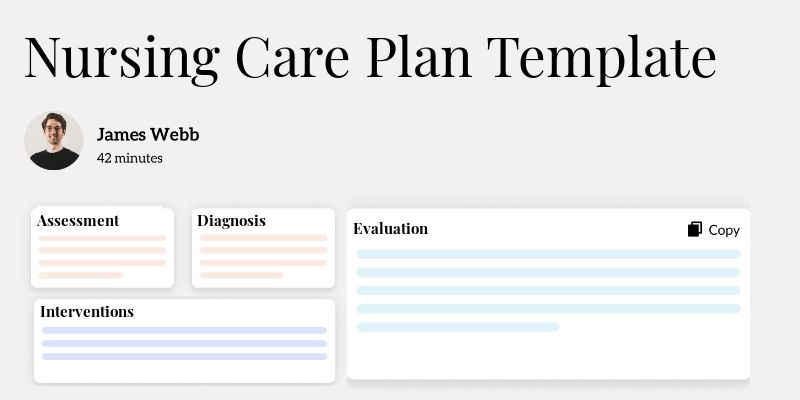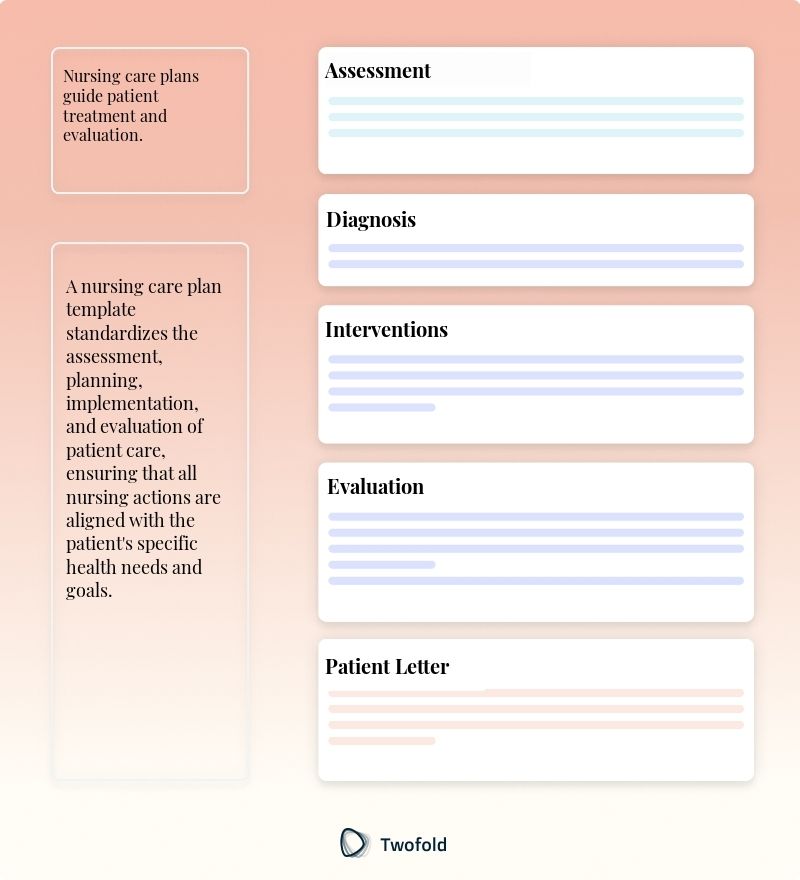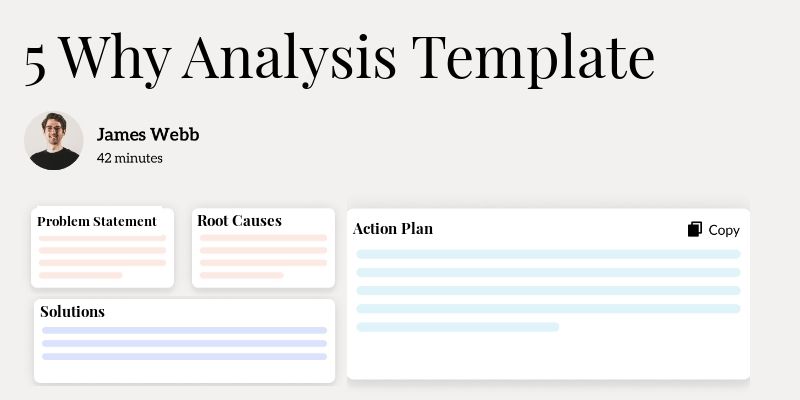
Nursing Care Plan Template
Whether you're a seasoned nurse or just starting out, the task of documenting a thorough nursing care plan can feel overwhelming. Wading through patient data, individualized health responses, and clinical guidelines to craft the perfect plan is no small feat. But don't worry—this guide is here to streamline that process and make your nursing care documentation a breeze.
What Is a Nursing Care Plan Template?
A Nursing Care Plan Template serves as a structured framework for nurses to document and implement patient care. This tool ensures a systematic and personalized approach by outlining interventions tailored to the patient's needs.
By using a template, nurses can efficiently organize patient data, clinical assessments, and therapeutic interventions, offering a consistent method to enhance patient care.
Key Components of a Nursing Care Plan
Each plan should include key sections that facilitate thorough documentation of patient care.
- Assessment: Comprehensive collection of patient data including medical history and physical exams.
- Nursing Diagnosis: Identification of patient issues based on the assessment.
- Planning: Setting realistic goals and expected outcomes for the patient.
- Implementation: Listing the nursing interventions and actions to achieve the goals.
- Evaluation: Reviewing the effectiveness of the interventions in meeting the goals.

How to Use a Nursing Care Plan Template: Step-by-Step Process
Step 1: Gather Patient Information
Collect complete patient information, including medical history and current health status.
Step 2: Conduct a Thorough Assessment
Perform a comprehensive assessment, noting physical signs, symptoms, and lab results.
Step 3: Formulate Nursing Diagnoses
Analyze the assessment data to identify current or potential health issues.
Step 4: Plan Interventions
Determine the most effective nursing actions that align with the patient's goals.
Step 5: Implement the Care Plan
Execute the interventions while involving other healthcare professionals as needed.
Step 6: Evaluate Outcomes
Assess the patient's progress and adjust the care plan accordingly to ensure goals are met.
Benefits of a Nursing Care Plan
Benefit | Description |
|---|---|
Enhanced Patient Care | Facilitates standardized and personalized care tailored to individual patient needs. |
Improved Communication | Supports clearer interaction among healthcare team members, promoting cohesive care. |
Legal Protection | Acts as an official record verifying thorough and systematic patient care delivery. |
Efficient Resource Use | Helps prioritize and allocate resources more effectively based on patient needs. |
Stakeholders in Nursing Care Plan
The creation and execution of a nursing care plan involve various stakeholders who contribute to its implementation.
- Nurses: The primary individuals implementing and updating the care plan. For example, in a busy hospital ward, nurses adjust care plans daily based on patient progress and new test results.
- Doctors: Provide medical orders and collaborate with nurses on care strategies, such as determining the appropriate interventions after a complex surgery.
- Patients: Actively participate in their care, providing input and feedback for personalized goal setting. Consider a patient with diabetes who works with nurses to incorporate dietary changes they can realistically maintain.
- Family Members: Offer insight into the patient's preferences and needs, enhancing care customization. For instance, families may share valuable history about a patient's sleep patterns influencing care decisions.
Example of a Nursing Care Plan PDF
To truly understand the format and structure, a downloadable PDF example can provide visual guidance and practical insights into crafting a nursing care plan.
Real-World Use Cases: Practical Impact of the Nursing Care Plan Template
These examples highlight the transformative effects on patient care delivery.
- In a rehabilitation center, a nurse uses the template to continuously update the care plan for a recovering post-stroke patient, leading to a significant improvement in mobility and independence.
- In an outpatient setting, consistent application of the care plan template helps a home-visiting nurse manage a diabetic patient's insulin administration and lifestyle adjustments, resulting in better blood sugar control.
- During a community health project, nurses use the template to organize and monitor health interventions for at-risk populations, significantly decreasing incidences of communicable diseases in underserved areas.
Conclusion
A Nursing Care Plan Template is a crucial tool that enhances patient care by offering a structured approach to nursing interventions. With its focus on assessment, planning, and evaluation, the template not only facilitates personalized care but also streamlines communication and legality within the healthcare team. By incorporating real‑world use cases and expert tips, nurses can leverage these templates to focus on delivering high‑quality, patient‑centered care.
Disclaimer: This article is for informational purposes only and does not constitute legal or medical advice. Always consult professional guidelines and regulatory bodies for specific compliance requirements.

Dr. Danni Steimberg
Dr. Danni Steimberg is a pediatrician at Schneider Children’s Medical Center with extensive experience in patient care, medical education, and healthcare innovation. He earned his MD from Semmelweis University and has worked at Kaplan Medical Center and Sheba Medical Center.
A care plan isn’t merely a paperwork requirement—it drives coordinated, outcome‑focused nursing. The ADPIE-Plus upgrade (Assessment, Diagnosis, Planning, Implementation, Evaluation + Progress checks) streamlines documentation while keeping goals patient‑centered and measurable.
- Targeted Assessments: Document only the findings that directly inform the nursing diagnosis (e.g., “2-day post-op pain 7/10 limiting ambulation”) so priorities stay crystal-clear.
- Goal-Action Pairing: For every nursing diagnosis, write one SMART goal and pair it with a specific intervention—this one-to-one mapping speeds shift handoffs and audit reviews.
- Progress Check Column: Add a quick-glance space for daily outcomes (e.g., pain ↓ to 4/10; ambulated 50 ft). Rapid updates prove effectiveness and flag the need for plan tweaks in real time.
Frequently Asked Questions
Reduce burnout,
improve patient care.
Join thousands of clinicians already using AI to become more efficient.

Medical History Form Template
Discover practical Medical History Form Template templates to enhance your documentation efficiency.

Social Work Treatment Plan Template
Discover practical Social Work Treatment Plan templates to enhance your documentation efficiency.

5 Why Analysis Template
Discover practical 5 Why Analysis templates to enhance your documentation efficiency.

